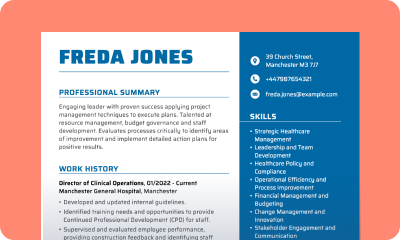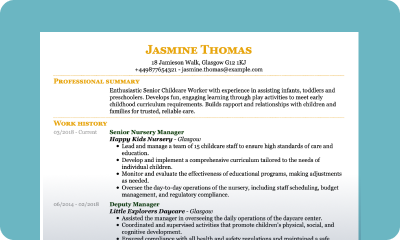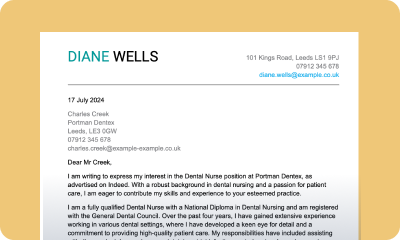How to End a CV to Impress Employers (With Examples)
How to end a CV? You’ve spent hours crafting the perfect beginning and middle of your CV – it’s only fitting that you end with a bang. While the conclusion is usually less important than the preceding personal statement, CV skills, and employment background sections, finishing with a flourish is the best way to gain an advantage over the other candidates. Ultimately, you want to leave a good taste in the employer’s mouth.

Our customers have been hired by: *Foot Note
By the time candidates reach the last few sections, they’ve often run out of steam. We’re not surprised – learning how to write a CV takes bundles of patience, perseverance, and passion. Nevertheless, rushing the conclusion has dire consequences and can change the employer’s perception of you at the last minute.
Slowing down and understanding how to end a CV will give you the best possible chances of impressing the hiring manager and securing an interview spot. You’ve already done most of the hard work, so we know you’re more than capable of crossing the finish line!
The following guide is a lifeline if you’re stuck for ideas. We’ll cover valuable information about qualifications, hobbies and interests, and references, paired with more general CV writing advice to simplify the process. What’s more, we’ve snuck in a few top tips about cover letters – the cherry on top of job applications.
Ways to end a CV
There are a few different ways to end your CV, depending on the overall structure and how much extra information you want to provide.
Like here:
STEP 1
End a CV with your Education or qualifications
In a conventional CV layout, education or qualifications come last. After your contact details and personal statement, work history and skills come next due to their relevance and importance. Finally, you can finish with your academic successes or technical training.
STEP 2
End a CV with Hobbies and interests
The other way to end a CV is with a hobbies or interests section. This is typically used if you have very relevant interests, such as travelling when applying for a tourism company or fine dining when working as a chef. However, you can also end with an interest section if you’re looking to add more selling points to an entry-level CV that is lacking in work history. In any case, it comes at the end of your CV, after education.
STEP 3
End a CV with References
It’s also worth mentioning references, which used to be a good way to end a CV. Nowadays, it’s a little outdated, so applicants often add ‘References available on request’. This is often included as a footnote on CVs, providing a simple and concise ending.
STEP 4
What about a cover letter?
Finally, there’s a cover letter. Because it’s sent alongside your CV, it may be the next thing recruiters read after finishing your CV. Of course, you can’t guarantee that they’ll have the time to read both – so make sure your CV works as a standalone document just in case.
How to end a CV with your qualifications
Ending a CV with qualifications can be a fantastic way to demonstrate your education and training to potential employers.
You can list your academic degrees, certificates, and any relevant training programmes including details such as the name of the institution, location and date of completion.
Make sure to keep this section concise and substantial, and highlight those qualifications that are most relevant to the job you are applying for.
By ending your CV with a qualifications section, you are able to demonstrate your knowledge and skills and make a strong impression on the hiring manager.
Qualifications can set you apart from equally experienced candidates, giving you an edge when the competition is fierce. While some jobs don’t require formal education, most do. Schools, colleges, universities, and more provide fundamental knowledge and the building blocks for glittering careers.
What qualifications can you include?
There’s no need to worry if you left school early or never gelled with academia – education goes far beyond traditional avenues. Alongside school, college, and university qualifications, you can discuss vocational NVQs, BTEC certificates, City & Guilds, and anything else relevant to the position you’re applying for.
Some people also include workplace training, such as health and safety courses or specialist driving licences. List these like any other qualifications or – if there are too many – place them in a separate section just above called “Certificates” or “Professional Qualifications”.
Thanks to the range of acceptable qualifications, job-hunting is much easier. You can always expand your knowledge in an adult learning course or head back to college – age doesn’t matter as long as you’re passionate about your subject.
Where to put education on your CV
Many people who are wondering how to end a CV get confused about the education section. Where does it go, and is it more significant than work experience? The answer isn’t clear-cut – it really depends on the job you’re applying for.
Education often comes after your contact details, personal statement, employment background, and CV skills. It’s followed by your interests if you’re including this section. That’s because it’s usually less important to employers as you can pick up most tricks of the trade on the job.
On the other hand, if you’re still studying, a school leaver or a recent graduate, you might not have much practical experience. In these cases, placing the education section ahead of your career history is more beneficial. Alongside your transferable skills, it’s the only way to prove your competence to prospective employers.
Similarly, you might want to spotlight your qualifications if you’re applying for a highly skilled or academic position, such as a teacher, lecturer, or doctor. In these instances, an interest section is the preferred ending.
How to structure the education section
Now onto the all-important question – how do you structure the education section? Like your work experience, organise your qualifications in reverse-chronological order. Typically, your most recent training will be more relevant, so you should highlight it at the top.
For instance, you might start with a postgraduate or undergraduate degree and then work your way back towards GCSEs. If you’ve completed a professional certificate, you could include this first unless you create a separate section. The order looks something like this:
- Workplace certificate
- Postgraduate degree
- Undergraduate degree
- A levels or equivalent, e.g. BTEC
- GCSEs
Alongside the type of qualification, note the awarding body, study dates and results. With GCSEs, you don’t need to include individual grades unless the employer asks otherwise. For functional courses, grades may not be applicable. Here are two examples for reference:
University of Bath | September 2019 – September 2022
BA (Hons) Business: First-class honours
Bath College | September 2017 – September 2019
4 A levels: Maths (A), Business Studies (A), Economics (B), and IT (B)
Bath High School | September 2012 – September 2017
11 GCSEs at grades A* – C
OR
British Safety Council, London | April 2022 – March 2023
Health and Safety Management for Construction
National House Building Council | September 2019 – September 2022
Level 3 NVQ in Construction Contracting Operations
Bristol College | September 2017 – September 2019
Level 2 Diploma in Business Management
Bristol High School | September 2012 – September 2017
10 GCSEs at grades B – C
How to make your qualifications stand out
While it might be tempting to aimlessly list your qualifications, especially if you studied many moons ago, employers rely on them to make final decisions. As such, there are a few things to keep in mind as you write.
Firstly, tailor your qualifications to the job description – there’s no point detailing your Geography, PE, and Music GCSEs if you’re applying for a computer engineering job.
On the flip side, you could include relevant modules to reinforce your expertise if you have minimal work experience. Let’s say you completed a BA (Hons) in Creative Writing but wanted to work as a food journalist – perhaps you specialised in Literature and Food.
Jot down your modules like this:
University of Manchester | September 2019 – September 2022
BA (Hons) Creative Writing: First-class honours
Modules included: Literature and Food, Introduction to Book Publishing, Short Stories, Creative Non-Fiction, and Ideas of Subjectivity
Dissertation: Food Blogging in The Twentieth Century
Finally, be tactical with the information you include. Unfortunately, a third-class honours (the lowest pass grade) doesn’t sound particularly impressive, so you might want to omit the grade. We also suggest leaving out older qualifications, such as GCSEs, if your CV is too long – it shouldn’t exceed two pages.
How to end a CV with your hobbies and interests
Hobbies belong to the additional, non-mandatory sections of a CV. However, if you choose to end your CV with a Hobby section, it can come in handy.
For example, if the hobby is related to the job you are applying for, it can demonstrate relevant skills or qualities that may set you apart.
For instance, if the job requires teamwork, listing hobbies such as team sports can show your ability to work in teams.
If the job requires creativity, listing hobbies such as painting or writing can demonstrate creativity and artistic abilities.
It’s an engaging little section at the bottom of your CV that paints a clearer picture of your character. Employers always prioritise candidates with shining personalities, and they’ll use this information to predict whether you’ll mesh with the company’s ethos and existing team.
In fact, most hiring managers are more concerned with your “cultural fit” than experience, so it’s smart to include details that make you sound human. Plus, outside pursuits make excellent ice-breakers and conversation starters if you reach the interview stage.
Who should add hobbies and interests?
Hobbies and interests aren’t mandatory, despite the benefits. When should you include them? If you have the space and need to bolster a sparse work experience or education section.
Skilled candidates often leave them out, so they have more words for their professional achievements. In this case, you’d end your CV with your qualifications section. However, this isn’t a hard and fast rule – decide what matters most to you.
What hobbies and interests can you include?
We know you’re raring to go but hold your horses. Remember, you’re still a professional trying to appeal to prospective hiring managers. Do you think they really want to know about your Game of Thrones binges or penchant for eating pizza in your pants on Saturday nights?
This isn’t a place for random ramblings – it’s a fantastic opportunity to show off applicable strengths. Of course, you should be authentic, but skip anything that’s too bizarre or banal. Here are a few popular hobbies and interests and the skills that relate to them:
- Sports – competitive, goal-oriented, and an excellent team player
- Chess – logical, analytical, and patient
- Gaming – computer literate, hyper-focused, and creative
- Blogging – articulate, imaginative, and communicative
- Acting – confident, extroverted, and a brilliant public speaker
- Music – disciplined, passionate, and committed
- Dance – self-aware, physically fit, and dedicated
- Travelling – adventurous, self-sufficient, and loves a challenge
How to structure your hobbies and interests
Generally, you should only include three interests at the end of your CV, or you might topple over two pages. We suggest adding a little extra detail to each so hiring managers get a better idea of your transferable talents.
- Acting
- Football
- Blogging
Try something like this:
- Acting – member of the local theatre group for seven years, performing in much-loved classics like “The Twelfth Night” and “A Streetcar Named Desire”.
- Football – goalkeeper for Rovers Athletic F.C. and coach for the under-10s team.
- Blogging – enjoys writing about football, travel, and up-and-coming plays.
How to end a CV with your references
Once upon a time, people included their references on their CVs, but nowadays, in most cases it is outdated. Employers usually ask for them later, so you don’t need to have them ready before sending your application.
Instead, note the following at the end of your CV:
References available on request
References are people who can vouch for your experience, skills, and character. They should be professionally linked, such as a colleague – friends and family are biased and don’t count. When it’s time to pass them on, seek permission beforehand and include:
- Full name
- Professional title and relationship
- Company name
- Company address
- Phone number
- Email address
Like in this example:
Finish your application with a cover letter
We can’t discuss how to end a CV without mentioning the cover letter – it’s the final piece of the puzzle and the last step before sending your application. While it’s a separate document and not technically part of your CV, most employers now require one for you to be considered.
Not sure where to start? Keep reading for expert guidance…
Why should you attach a cover letter?
If you’ve already written a great CV, why do you need a cover letter? Good question. This short one-page document provides the employer with additional information about your abilities and how they align with the role, what unique skills you can bring to the table, and why you applied for the position.
Moreover, hiring managers read hundreds – if not thousands – of applications. A well-written and thoughtful cover letter distinguishes you from other candidates.
What to include in a cover letter
Cover letters don’t have to be a chore – simply follow the below formula. We’ve broken the structure down into digestible chunks so you can focus on finessing your content.
STEP 1
Start by writing a header with your contact details.
STEP 2
Open your letter with a formal greeting, e.g. Dear Hiring Manager.
STEP 3
Use the introduction to explain why you’re interested in the offer.
STEP 4
In the main body, convince the reader you're the right candidate for the job by presenting your most desirable skills and accomplishments.
STEP 5
Conclude by expressing your readiness to work, noting your interview availability and notice period.
Top tips for writing a cover letter
Tailor the information to the job description
Ensuring information is to the point and relevant applies across the board. You can’t send cookie-cutter cover letters – or CVs, for that matter – because every position demands slightly different skills, experience, and qualifications.
Some people think they can get away with generic statements to save themselves the extra hassle, but employers always see through this. If you don’t provide specific examples, your writing becomes too general. To hammer home the point, which sounds better?
I believe my skills would make me the best candidate for the role.
OR
My in-depth technical knowledge and experience working in a busy retail environment would be an asset to your team. Over the years, I’ve developed strong communication skills from liaising with suppliers and customers, which have fed into my outstanding sales figures.
Show enthusiasm and willingness
Hiring managers love confident candidates who convey enthusiasm and willingness – it’s the kind of energy they want to bring into their team. But how do you do this if you’re not a natural wordsmith? Our top advice is to lean on positive adjectives and action verbs.
Positive adjectives speak to your personality and give the employer a better idea of how you’d conduct yourself in the workplace. We recommend using unique words, such as:
- Diplomatic
- Assertive
- Results-driven
- Progressive
- Diligent
Action verbs are powerful alternatives to “responsible for” – they show off your accomplishments better than simply listing your duties. Some of our favourites include:
- Engineered
- Founded
- Delivered
- Simplified
- Transformed
Offer context and additional details
The cover letter is the perfect place to provide context and additional details. For example, you might want to explain gaps in your career history – many people travel, raise families or concentrate on their own businesses before jumping into traditional 9 to 5 employment.
Furthermore, candidates often make the mistake of including their career ambitions in their personal statement, but it’s more suited to the cover letter. You could outline what you hope to achieve at the company and why you were initially interested in the position.
Ending a CV - why does it matter
If you’ve ever watched an amazing film tarnished by the final scene or had an entire meal ruined by a lacklustre dessert, you’ll already know the importance of endings. They can make or break a job application and sway unsure hiring managers to give you a shot. Plus, the concluding sections still offer fascinating insights into your professional life.
Understanding why endings matter gives your writing purpose. Instead of rushing, you’ll feel motivated to pay attention and put your best foot forward.
Leaves the employer on a high
There’s nothing worse than starting off strong and slowly losing the employer’s attention before they’ve made a decision. Plus, providing an incomplete picture of yourself – such as bypassing your qualifications – might give the impression you have something to hide.
Completing your CV correctly will present a well-rounded view of your capabilities and reassure the reader you’re the right person for the job. Once they’ve reviewed all the applications, yours should be the one they’re still thinking about!
Ties up loose ends
Perhaps the hiring manager is on the fence because they don’t know much about your personality? Or they might be unconvinced whether you have the right educational background to hit the ground running. Luckily, the concluding sections tie up niggly loose ends that could scupper your chances of success.
Helps formulate the next steps
Including additional information at the end of your CV or cover letter helps the hiring manager formulate the next steps. For example, you could mention your availability for an interview, notice period, or willingness to relocate. Having these details on hand speeds up the recruitment process.
How to end a CV - final tips
Double-check your work for errors and cohesion
Nothing grinds a hiring manager’s gears quite like spelling and grammar mistakes, especially as they’re so easy to resolve. We advise running your CV through a free programme like Grammarly and scanning for any repetitiveness or awkward phrasing.
Sometimes, a fresh pair of eyes can pick out fiddly errors you might have missed. Ask a friend, family member, or trusted colleague to give you some feedback before finalising your application. The more input you have, the more accurate your CV will be.
Lastly, check you’ve hit all the important points. Does your personal statement highlight your best CV skills? Have you organised your work experience, so the most relevant positions are at the top? Are your contact details correct?
Send your CV to the right people
You’ve found your dream job, created an exceptional CV, and attached a complementary cover letter – so why haven’t you heard anything back? The answer might be as simple as you’ve sent your application to the wrong person. It’s easier to do than you think.
Usually, the employer’s email address will be somewhere in the job description. However, if you’re sending your CV to a company you love in the hopes of securing a placement, you’ll need to research the best point of contact. As a rule, avoid general email addresses like “mailbox@lighthouse.com” and identify key decision-makers.
Your email doesn’t have to be too long – after all, you’ve already created a CV and cover letter. Here’s a good template to follow:
- Add the reason for your email in the subject line, e.g. Retail Assistant Job Application
- Greet the recipient by name, introduce yourself, and restate your interest
- Attach your documents (they’re better than links – the latter often go to spam)
- Close the email politely with your full name and contact details
Use the correct document format
Like the employer’s email address, the job advertisement should outline how to save and send your CV and cover letter. Usually, this will be as PDF or Word file. If you don’t use the correct file type, you might mess up the formatting or prevent the hiring manager from accessing your documents.
Takeaways for how to end a CV
How you end your CV is almost as important as how you start. While many people rush through the final few sections, you won’t make the same mistake. Qualifications and interests are the two conventional ways to end a CV, though it’s also important to impress with your cover letter in case this is the final thing recruiters read.
Need more advice? Check out the handy tools on our website. We have hundreds of CV examples, CV templates, and online advice to guide you towards success.

Jagoda Jaskowicz
Senior Content Editor, Translator
*The names and logos of the companies referred to above are all trademarks of their respective holders. Unless specifically stated otherwise, such references are not intended to imply any affiliation or association with myperfectCV.










